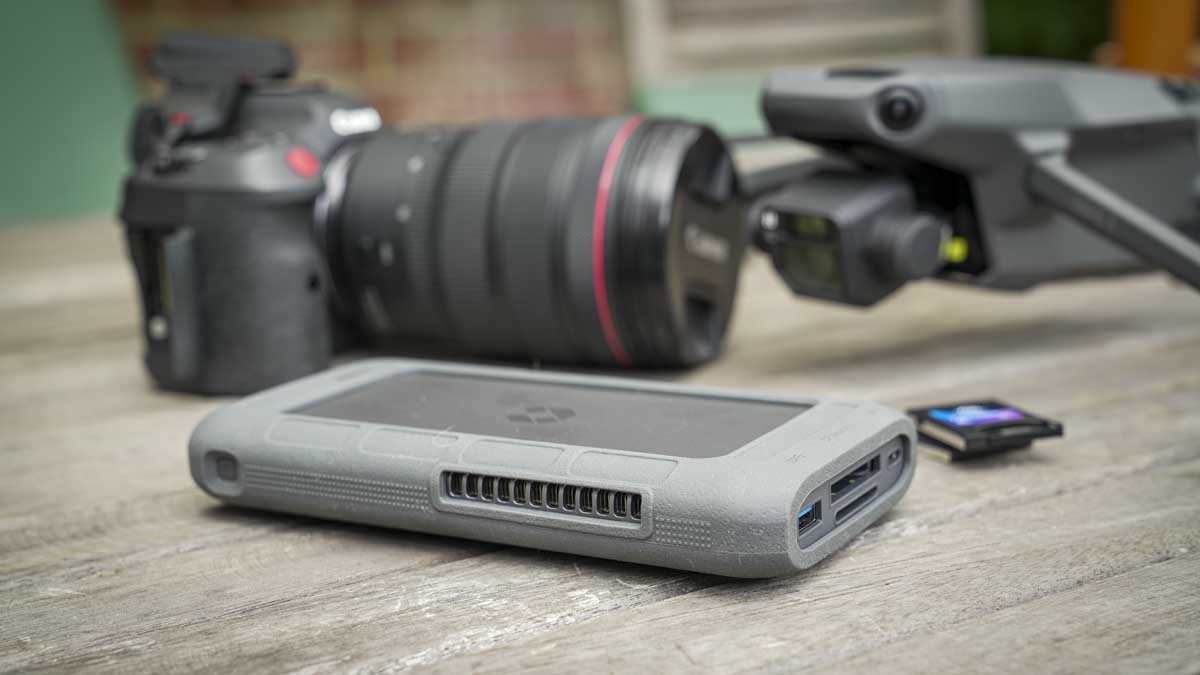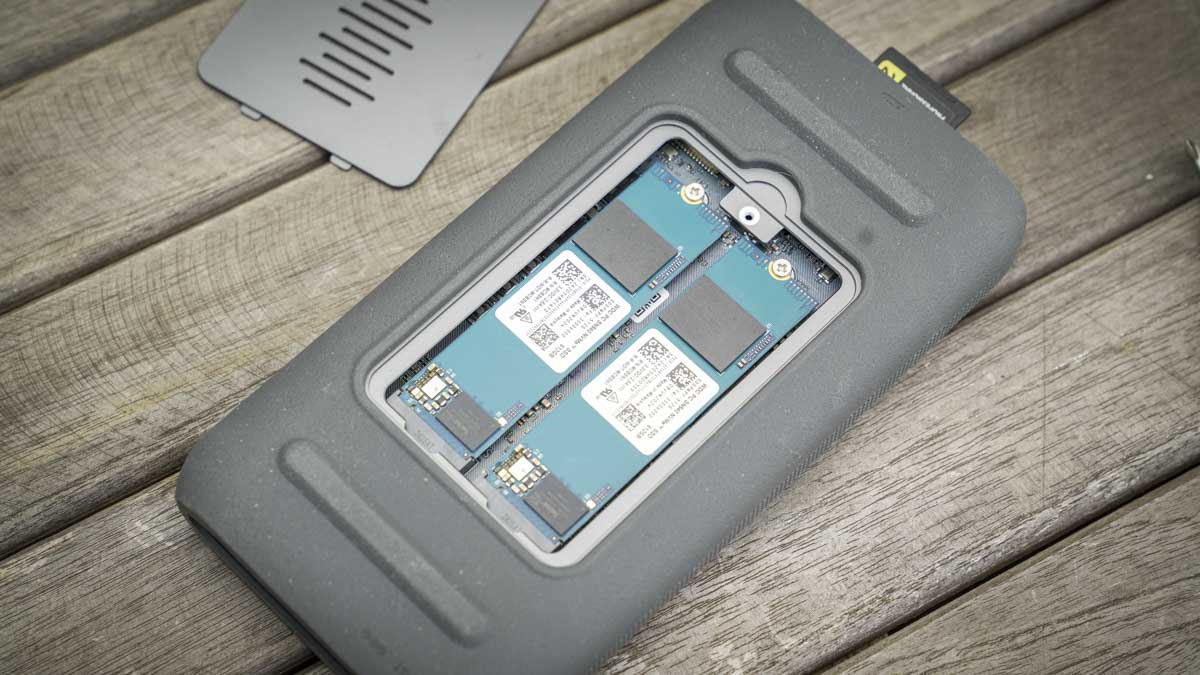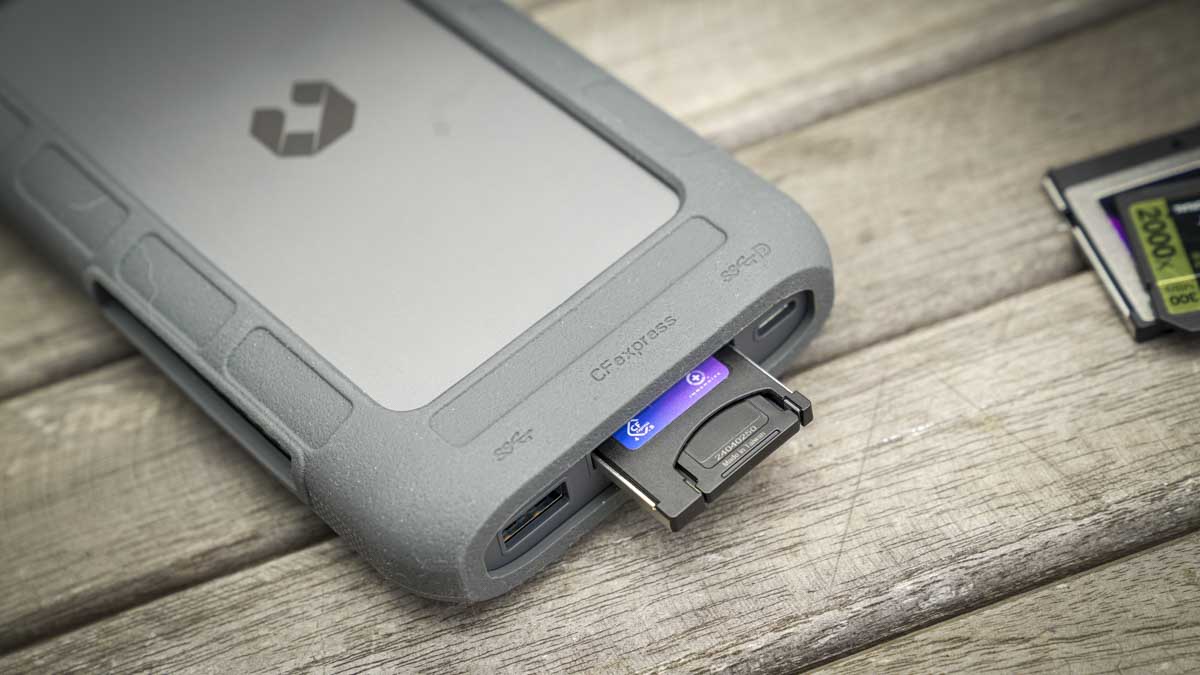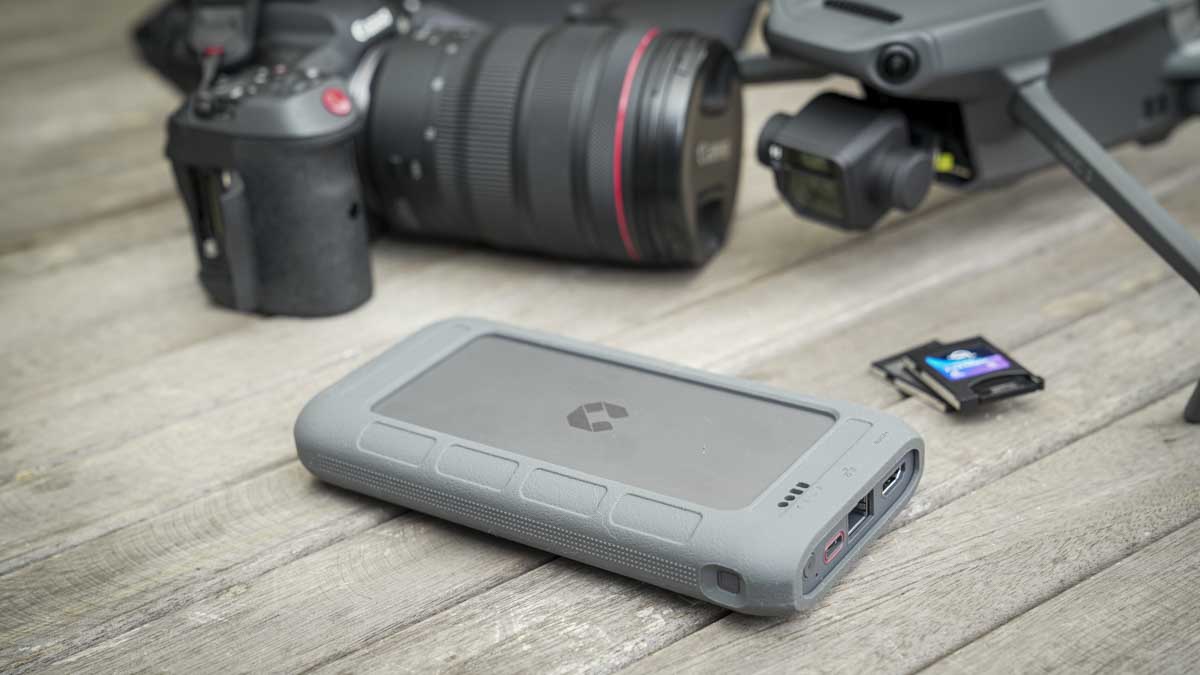TechRadar Verdict
The UnifyDrive UT2 is a fully portable NAS drive that enables you to download from memory cards, work collaboratively, and backup your work, There's a few small issues, but ultimately this NAS offers something unique and fills a gap that many creatives have been calling for.
Pros
- +
Portable NAS drive
- +
16TB RAID storage
- +
Direct media download
Cons
- -
Short battery life
- -
UHS-II card issues
- -
RAW thumbnail limitations
Why you can trust TechRadar
UnifyDrive UT2: 30-second review
CPU: RK3588C4 Cortex-A76 + Cortex-A55
Graphics: ARM Mali-G610 MC4
RAM: 8GB LPDDR4
Storage: Up to 16TB NVMe M.2 2280 SSD (RAID configurable)
Rear Ports: USB Type-C (power), Ethernet (2.5GbE), HDMI 2.1
Front Ports: CFexpress Type B, USB Type-C, SD card slot
Connectivity: Wi-Fi 6 (802.11ax), Bluetooth 5.0
Audio: N/A
Camera: N/A
Size: 170mm x 85mm x 21mm (without case), 173.5mm x 90mm x 28mm (with case)
OS installed: Custom NAS OS with mobile and desktop apps
Accessories: Silicone protective case, power adapter, remote control
The UnifyDrive UT2 is one of the first truly portable NAS (network-attached storage) drives on the market, designed for creative professionals looking for a powerful, portable NAS storage solution. The UT2's compact size, is just slightly larger than a typical mobile phone, which makes it easy to carry, while its tough rubberised case offers durability in the field.
When it comes to design, despite the compact size there's plenty of connections and ports, on the back, there's a USB Type-C power input, Ethernet, and HDMI output, while the front features a CFexpress Type B and USB Type-C port.
Alongside the wired LAN port, the UT2 is equipped with both Wi-Fi and Bluetooth, offering plenty of network connection options. When it comes to the NAS storage option, the UT2 holds two NVMe M.2 2280 SSD, enabling up to 16 TB of internal storage. This can be configured for RAID mirroring or performance, depending on your requirements.
If you're a content creator, the ability to download footage and images directly from your camera, drone or other device will be appealing for backup, sharing and viewing. All you need to do is insert a CFexpress or SD card into the front of the UT2, and with a quick double-press of the "PlugBackup" button, the data begins transferring. Two beeps signal a successful start and three beeps confirm the download is complete.
Once the data is on the internal SSD, it can be accessed through the mobile app, which is straightforward and user-friendly. As this is a NAS, multiple users can then access the files simultaneously, making working in a creative team far easier. Setting up the NAS does require some configuration, but it's not overly complicated compared to other NAS systems and of course this is completely portable.
While the UT2 shows a lot of promise, it is still in the early stages of release, and there are a few bug. For example, when connecting directly to a computer without external power, the UT2 can sometimes disconnects, particularly with MacBook Pro's. However, this issue is resolved by connecting external power. UHS-I and CFexpress cards are recognised quickly, but some UHS-II SD cards take longer, and some are recognised but won't mount.
Then there's the internal battery, which is a nice feature but the power is limited, lasting about an hour. External power sources, such as the UGREEN Nexode 130W, can be used to boost the internal battery in use. In a home or studio setup, the UT2 connects directly to a router, functioning as a traditional NAS with all the expected features.
Sign up to the TechRadar Pro newsletter to get all the top news, opinion, features and guidance your business needs to succeed!
What sets the UT2 apart from many of the best NAS hard drives we've reviewed is that it can also act as a standard flash drive, although the NAS and flash storage aren't fully integrated. Files downloaded to the NAS cannot be instantly shifted to a computer via USB Type-C; instead, a LAN connection is required, while this will make sense to those familiar with NAS for those used to standard hard drives, this will seem a little odd at first.
The UnifyDrive UT2 is an excellent portable NAS solution that will find wide appeal in the creative sector. Despite a few bugs and workflow challenges, it's an impressive product that you can easily customise to your own workflow.
UnifyDrive UT2: Price & availability

The UnifyDrive UT2 is currently available for pre-order through Kickstarter, with pricing depending on storage options and features. Early backers can purchase a UT2 at a discounted price, while later orders will likely see an increase as the product moves towards full retail availability.
- Score: 4/5
UnifyDrive UT2: Design & build

The UnifyDrive UT2 has been designed as a portable NAS drive, making it ideal for on-the-go creative professionals working in the field, to further boost it's potential, the UT2 comes encased in a rubberised exterior jacket to help protect it from knocks and bashes. This design and style instantly mark out the UT2 as something different. Sure enough, inside this NAS is space for two ultra-fast NVMe M.2 2280 SSDs, which means that you can max it out with 16 TB of storage, although once your choice of RAID has been applied, this does obviously reduce. Then there's the internal battery that, coupled with the Wi-Fi and Bluetooth, means that you can use this NAS storage away from traditional networks, using the devices as a hotspot that other devices can connect to to access the contents.
Unlike the best portable SSD units, which the UT2 has more than a passing resemblance to, a NAS requires processing power. In a device this size, that's impressive, and UnifyDrive has borrowed that processing and graphics power from a smartphone-grade CPU and GPU, which makes sense given the power of modern mobile processors. This enables the UT2 to deliver high-performance NAS functionality in this pocketable form.
In terms of size, the UT2 is impressively small for a fully-featured NAS system. Without the protective silicone case, it measures 170mm by 85mm by 21mm, and with the case, the size increases slightly to 173.5mm by 90mm by 28mm. It weighs 306g without the case and 371g with, making it easy to slip into a pocket or backpack without adding too much weight or bulk.
The overall design is solid, with the rugged silicone casing that surrounds the metal and plastic body, reminiscent of the iconic LaCie rugged drives, though in grey rather than bright orange. The ports are all easily accessible, and a large ventilation slot on the side helps to ensure decent airflow to keep everything cool.
A major design feature of the UT2 are the USB Type-C, CFexpress Type B, and SD card slots on the front. While on the back there's the power button, an additional USB Type-C port (for power), Ethernet, and HDMI output.
- Design: 5/5
UnifyDrive UT2: Features

Despite its small size, the UT2 is packed with features, starting with the CPU and GPU. It is powered by the RK3588C4 Cortex-A76 + 4 Cortex-A55 CPU, paired with an ARM Mali-G610 MC4 GPU. Complementing this combo is 8GB of LPDDR4 RAM.
Like most NAS drives, the UT2 includes a 2.5GbE RJ-45 Ethernet port, and internally, it has two M.2 slots for PCIe 3.0 NVMe 2280 SSDs, allowing for up to 16TB of storage. The two SSD slots enable the NAS RAID configurations so that you can optimise the space for speed or safety.
There's a host of features that will appeal to creatives, especially photographers and videographers, most notably the SD and CFexpress Type-B port, with adapters available for Type-A cards and MicroSD cards. These ports allow for automatic downloading of memory card contents by double-pressing the button on the side. All activity for this as well as other functions can be monitored through the companion app, available for iOS and Android.
The UT2 is also compatible with a range of apps, including multimedia and image viewers. As with other NAS systems, these apps enable you to perform many in-device processing tasks, such as video transcoding and AI-assisted organisation of media files.
Further highlighting that the UT2 is something different is the HDMI 2.1 port on the back, while some NAS also feature a display port of some type to access the command line interface, here it's used for connecting directly to a display or headset, enabling direct media playback.
In terms of connectivity, alongside the Ethernet port there's also Wi-Fi 6 (802.11ax) and Bluetooth 5.0. Power to the NAS is supplied either by the internal battery offering around an hour and an hour to an hour and a half, depending on usage, and this is complemented by a PD Type-C 12V 2.75A charging port.
The silicone case around the UT2 offers plenty of protection when used out in the field and when being transported, giving dimensions of 173.5mm x 90mm x 28mm and weighing in at 371g.
While the UT2 looks like a portable hard drive, it is in fact a far more featured portable NAS system and, as such, is fully configurable like any other NAS solution. Depending on configuration, you can put in up to 16 TB of storage (or 8TB in RAID 1 for mirroring). You can either plug it into your LAN and use it as a standard NAS, or use it as it has been intended out in the field away from the office or studio wirelessly. This functionality enables you and multiple other users to log into the NAS out in the field via Wi-Fi, which is something new for this size and simplicity of device for collaborative workflows on location.
In addition to NAS storage, the UT2 also offers an option for more traditional flash storage, which can be accessed directly through a USB Type-C connection to your computer. In order for this to work, it requires setting up a partition separate from the NAS RAID, another handy feature.
The desktop client and mobile app enable full access to the UT2 features, of which there's already an extensive list. One of the other features that will really appeal is the automatic cloud backup that enables the UT2 to connect to your preferred server for cloud backup. Once done, the contents from the NAS are uploaded automatically to the cloud when it has an internet connection, and you can even set it up so that it will back-up your mobile and computer to the internal storage and then to the cloud, giving you three copies of your systems.
The UT2 offers an impressive range of features, and as you start using the NAS, you'll discover ways to tailor it to your workflow. While some features are still under development, as it stands, the UT2 already offers far more than most and something quite unique as a truly portable NAS system.
- Features: 4/5
UnifyDrive UT2: Performance

Getting started with the UT2 requires setting up a few different areas of the NAS with the first steps to download the mobile app and desktop client. Once done, you can install the two M.2 2280 SSD modules; the slots are accessible via the base of the device with the cover held in place by a single screw.
After installing the SSD's to start the NAS, plug it directly into your LAN and connect the USB Type-C power cable into the rear port, highlighted with a red ring. Press the power button on the back, and after a few seconds, the device boots up with a loud beep.
Next, launch the app or desktop client on your computer or mobile. The system will guide you through formatting the drives and provide access to extensive drive management software, similar to what you'd expect from larger NAS systems. You can configure the RAID setup, create shares, and toggle additional features such as HDMI output and flash drive mode, which require you to partition a section of the storage so that it can be viewed as an external drive.
The Flash Drive mode acts like a standard external SSD with a direct USB Type-C connection, enabling direct access to the flash partition. So while it is one device, you need to connect in different ways to access the different partitions of the storage, in essence as if they were two separate devices. Files in the flash partition are accessible via the NAS, but the NAS section can only be accessed through the network client or by connecting to the server and not directly through the USB connection unless through the client.
This setup allows you to partition part of the drive for use as a standard portable SSD while harnessing the power of NAS. When working in the field, you can connect the UT2 to your machine for editing, then upload finalised files to your colleagues or allow them to access the partitioned drive as an external network drive to view the necessary files.
One feature that will really appeal to creative professionals is the ability to download media from memory cards directly to the drive through the two slots on the front. These include an SD slot (with support for microSD/TF cards using adapters) and a CFexpress Type-B slot commonly used by Nikon and Canon cameras, and an adapter can also be used for USB Type-A cards found in Sony cameras.
The download process is initiated by inserting a card and double-pressing the PlugBackUp button on the side of the device. A double beep indicates that the process has started. During testing, all SD UHS-I cards were downloaded without issue. However, some SD UHS-II cards weren’t recognised. CFexpress Type-B cards were recognised, although larger-capacity cards had a slight delay before confirmation. Download progress can be monitored through the app, and three beeps signal that the files have successfully transferred, with 10 GB taking around 3 minutes and 30 seconds.
Once the files are in place, they can be accessed via the network—whether at home or in the studio—through LAN or Wi-Fi. The ability for multiple users to connect to the NAS and view the files gives the UT2 an edge over standard portable hard drives and other systems. Then there's the pre-loaded apps, such as photo viewers, so that you can allocate the files that have been downloaded to albums for quick access and sharing
One drawback with the current setup is that while JPEG thumbnails are viewable, RAW files are not. Additionally, some video file formats aren't fully compatible for playback directly from the cameras. Nevertheless, all file types copied and stored correctly on the NAS and the fact that you have those features, if not fully encompassing, is something new at this level anyway.
When it comes to speed, different connection methods offer varying results. The slowest test was through a wireless LAN connection, where speeds reached 5.7 MB/s write and 9.3 MB/s read; this involved wirelessly connecting the UT2 to a wireless router so it appeared on the LAN.
A better way to connect, especially in the field, is to use the UT2’s Wireless Hotspot feature, with 67.2 MB/s write and 82 MB/s read. However, if you want the fastest speeds, then using the USB Type-C connection to access the Flash storage SSD partition enables transfer rates of 303 MB/s write and 320 MB/s read, although the downside is that this direct connection only enables a single user.
One issue encountered was random disconnections when the battery was running low, even when plugged in to power. Keeping the battery at least 50% charged or using an external power source helped resolve this.
In the final test, the UT2 was connected directly to a local wireless LAN, which enabled write speeds of 23 MB/s and read speeds of 32 MB/s, allowing for multiple concurrent connections.
The UT2 performed well when used with multiple devices, maintaining decent transfer rates. The photo app further boosted the usability of the NAS by allowing file sharing with others on and off-site.
However, the UT2 is still in its early stages, and while its vast array of features may seem overwhelming at first, you quickly develop a workflow that suits what you need from it. UnifyDrive has done a lot to simplify the process, though it may take some time to get accustomed to this new technology.
For photographers, the UT2 is particularly valuable. You can take pictures in the field, download them directly to the UT2, and then allow clients to access the images on their phones or tablets via the app. Assistants can also connect, download, and begin editing images, uploading them back to the NAS for easy sharing—all without the need for an internet connection. After the shoot, you can connect the UT2 to a monitor or projector and use the remote to flick through the images before sending them to their final destination.
While some features take time to get used to, such as the delayed boot time when first plugged in and the relatively short battery life (lasting around an hour), the UT2 offers a unique and mobile network solution for photographers and other creatives. A portable power source is recommended, and there is the more pressing issue of UHS-II cards, which failed to mount in most cases.
The lack of RAW file thumbnails is a minor, but similar systems (like the now-discontinued GNARBOX 2.0) suggest that future updates may address this issue.
- Performance: 4/5
Should you buy the UnifyDrive UT2?
The UnifyDrive UT2 offers an excellent, and realistically only, portable NAS system for creative professionals, especially photographers and videographers. It's packed with features, but most notably the ability to directly download footage and images from the memory card to the internal storage, with up to 16 TB of RAID capacity. The fact that you also have the option to configure one-step cloud backup further streamlines the more mundane aspects of the creative process.
The NAS system enables multiple users to access files at the same time, making it potentially an extremely useful tool in small production environments. A photographer can shoot, download everything to the NAS, and allow others to view or manage files. Wireless backup further streamlines this process.
The UT2 also enables you to connect directly to projectors or displays, making file review or presentations easy on the go, though navigation with the remote could be improved. Then there's the AI-driven media management features through the app, which add further functionality, making organising and sharing files easy.
While there are some issues, such as limited battery life, unrecognised UHS-II cards, and minimal thumbnail support for certain media formats, the UT2 delivers more than most portable drives, standard and NAS, available today. Overall, it’s a powerful mobile storage solution that brings the benefits of a NAS system to the field.
| Row 0 - Cell 0 | Row 0 - Cell 1 | Row 0 - Cell 2 |
Value | Offers unique portable NAS features but falls short in some areas. | 4 |
Design | Compact and rugged design, ideal for field use and portability. | 5 |
Features | Packed with useful features, though some still need refinement. | 4 |
Performance | Impressive speeds, but card compatibility and battery life could improve. | 4 |
Total | A versatile solution for creatives with a few minor drawbacks. | 4 |

Buy it if...
You need portable, high-capacity storage on the go
The UnifyDrive UT2 is perfect for photographers, videographers, and creatives working in the field, offering a high-capacity, RAID-configurable storage solution that is compact and rugged enough for easy portability.
You need easy media transfer and sharing capabilities
If your workflow involves backing up and sharing media files on-site, the UT2's direct file transfer and wireless NAS features allow multiple users to access data and collaborate in real time without the need for a traditional network setup.
Don't buy it if...
You require long-lasting battery life
If extended battery life is essential for your work in the field, the UT2 may not be the best choice, as its internal battery only lasts about an hour without external power, limiting its usability during longer shoots.
You rely on UHS-II SD cards frequently
If you use UHS-II SD cards regularly, the UT2 may frustrate you with its card compatibility issues. Some UHS-II cards may not mount properly, which could slow down or interrupt your workflow.
For more professional storage, we reviewed the best NAS devices.
Alastair is a photographer, filmmaker and tech writer who has been working in the publishing industry since the late 1990s. For more than 25 years he has covered photography, video and technology across Future's photography, technology and gaming brands. He runs a photography and video production company and lectures in TV and film. He can usually be found testing mini PCs or prototyping and prop building with the aid of 3D printing.
